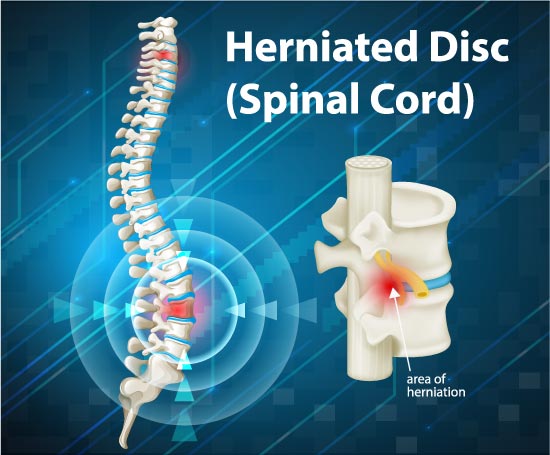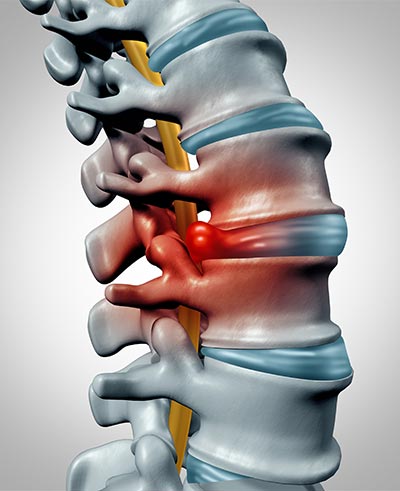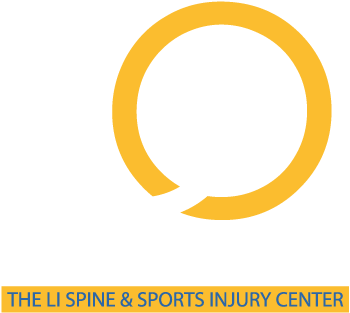Chiropractic Care for Herniated Disc
Disc Problems Due to Accidents and Injuries
Disc problems can be created by trauma, such as auto accidents, sports injuries, falls, lifting, poor posture, and workplace accidents. Major traumatic injuries can cause damage or weakening of the discs and create a disc problem. Additionally, when the bones are not moving properly, or there is a misalignment of the spinal bone, it will create degenerative changes within the disc, which leads to degenerative disc disease.
Spinal bones are made to move a certain way, and the only way that the disc gets nutrition and remains healthy is when the bones are moving properly above and below the discs. When an accident or injury disrupts the proper movement of the spine, not only can you experience pain, but your range of motion will decrease, and the function of your muscles and organs can be impaired as the nervous system is no longer able to properly communicate with them.
What is a Disc, and What Does it Do?
The disc is the cartilage between the spinal bones (vertebrae). The outer part of the disc is a fibrous material that contains the inner part of the disc, which is more of a gel-like material called the nucleus pulposus. The disc acts as a shock absorber, or cushion, and a spacer between the vertebrae of your spinal column. The disc material is softer so it absorbs the shock of the body when you are walking, running, working out, twisting and bending and allows for spinal movements. These discs also create the space in between the bones that allow the nerves to exit out in between the bones. The discs separate the spinal bones creating a hole called the intervertebral foramen where the nerve comes out. If you have problems with the disc, as it degenerates, or the disc bulges or herniates out, it can put pressure on the nerves causing all different kinds of problems including pain.
Symptoms of Disc Problems
 Often disc herniations are in the lumbar spine (lower back) or in the cervical spine (neck). Some of the symptoms could be numbness, tingling, burning or aching sensations into the legs all the way down into the feet and into the toes. Or you can get tingling, numbness, burning or aching sensations that radiates down the arms and into your fingers.
Often disc herniations are in the lumbar spine (lower back) or in the cervical spine (neck). Some of the symptoms could be numbness, tingling, burning or aching sensations into the legs all the way down into the feet and into the toes. Or you can get tingling, numbness, burning or aching sensations that radiates down the arms and into your fingers.
Lower Back Pain (lumbar spine) with radiation into the legs
The lower back has a series of nerves called the lumbosacral plexus that exit out from the lower back and run down into the legs. These include the sciatic nerve, which is the nerve that runs down the back of the leg to the feet. The femoral nerve, which is the nerve that goes into the front of the leg, also exits from the lower back.
Neck Pain (cervical spine) with radiation into the arms
There are a series of nerves called the brachial plexus, that exit out of the cervical spine (neck), and run down your arms and into your fingers. Disc problems in the neck show up in symptoms such as frequent headaches, sleep issues. Another symptom we see is pain between the shoulder blades. Nerves in the neck affect the rhomboid muscles. Since the rhomboid muscles start at the base of the neck and run down, attaching to the scapula (shoulder blade) not everyone is aware that disc problems in the neck can be a source of their pain.
Diagnosing and Treating a Herniated Disc
At Long Island Spine & Sports Injury Center, disc problems are something we treat our patients for on a daily basis. There are many different phrases people use to refer to herniated discs. Here are some of the most common ones. These different terms are based on what the disc looks like when viewed on an MRI.
- Herniated disc
- Protruded disc
- Bulging disc
- Extruded disc
- Sequestered disc
- Ruptured disc (a layman's term, not a clinical word)
- Slipped disc (a layman's term, not a clinical word)
When patients come into our office we always do a full and thorough examination, which includes a consultation, a thorough exam with orthopedic, neurological, and physical exam tests. We can use X-Rays to visualize the spine and see if you have any misalignments, disc degeneration, or osteoarthritis that can be contributing to your condition. If we see degenerative disc disease (the disc getting smaller than it should be) this indicates that the disc is degenerating and most degenerative discs have a bulging or herniation associated with it.
Here are some of the common findings the exams can reveal:
- Pressure on the nerves that exit out of the spine and shoot down into the arms and into the legs can decrease deep tendon reflexes in the arms or legs.
- We also check sensations using the pinwheel, or pinprick. If the patient senses a decreased sharp sensation that means that the sensory nerves, (which come out and go down into the arms or into the legs) are being affected.
- During orthopedic testing, we put the spine in different positions, and if it re-creates the radiation of pain in the arms and legs, this could be indicative of a disc problem going on.
The best way to see a herniated disc is with an MRI. An MRI allows us to see the disc and the water content of the disc, to see if the disc is bulging or herniating out, and to see if the disc is obstructing (occluding) the hole where the nerve comes out.
Chiropractic Care Services for Herniated Disc Problems
We are very successful in treating disc problems. A lot of our patients have disc problems that we are able to successfully treat. Of those that have disc problems — herniated discs, protruded discs, bulging discs, extruded discs, slipped discs, or sequestered discs — a high percentage of these people, we are able to find the cause, eliminate the pressure on the nerves, and we keep most people away from surgery.
After reviewing the results of our exams, we will plan a course of treatment with our patient to correct their problem. The course of treatment may include some or all of the following:
- Flexion Distraction:
Effective at increasing the intervertebral disc height, creating more room for the nerves while improving circulation. This also allows the center of your disc (nucleus pulpous) to move back into its proper position in the spine.
- Specific Chiropractic Adjustments:
Chiropractic adjustments that remove subluxations (misalignments) and restore proper movement to the spine.
- Active Release Therapy & Electronic Muscle Stimulation:
Using Active Release Techniques, electronic muscle stimulation (EMS), to help decrease pain, decrease inflammation and help speed up the healing process.
- Rehabilitative Exercises:
When we do rehabilitative exercises, we strengthen and stabilize the muscles around the spine. This allows the spine to move better, and this, in conjunction with chiropractic adjustments, helps to get the disc and spine healthier.
Chiropractic treatment involves adjustments, which are a gentle, effective way of moving the spine from the misalignment into its correct position and increasing the range of motion and flexibility of the joints. As we adjust the spine and get it into a better position, we are able to shift the disc material away from the nerve, which takes the pressure off the nerve, alleviating the symptom. When we adjust somebody’s spine, we are able to increase motion and correct the misalignment of the spine, which allows the disc to get healthier and stops or prevents the degeneration from progressing, in addition to taking pressure off the nerves. We also get our patients to start doing rehabilitative exercises. This helps to prevent them from needing surgery.
When someone comes in and they have a disc problem there are three phases to care:
- Phase 1:
The first phase, and our initial goal, is to get the pressure off the nerves — in other words, to decrease the pain. Only 10% of your nervous system feels pain, so once someone’s pain is alleviated and they feel better, they are basically 10% fixed, just patched up at that point.
- Phase 2:
Phase two is the corrective phase. As we continue to adjust the spine and do rehabilitative exercises to strengthen and stabilize the spine and correct the disc problem as much as possible. During this phase, we get as much pressure as possible off the nervous system.
- Phase 3:
The third phase would be more wellness and preventative care. Once your disc problem has been corrected and you are out of pain, if you keep the spine in a good position, keep it moving properly it is going to help prevent further progression of disc degeneration, disc herniation, and help keep your spine healthy.
Consult Dr. Gary Olson
At Long Island Spine & Sports Injury Center, we provide chiropractic care for herniated discs and other related problems on a daily basis. Contact us at (631) 462-0917 to arrange for a consultation. Please recommend this article to share the information with your friends and family.
© 2017-18 Dr. Gary Olson DC, PC, The Long Island Spine & Sports Injury Center
These articles are the property of Dr. Gray Olson DC, PC. They may not be reused without permission. You are welcome to link to this article. Dr. Gary Olson has been proudly serving Long Island, NY since 1999.
The contents of this website are based upon the opinions and experience of Dr. Olson. The information on this site is not intended as medical advice. The information contained on this website is a sharing of knowledge based on the experience, training, and research of Dr. Olson. Dr. Olson recommends that patients make their health care decisions after doing their research and consulting with a qualified health care professional.
Contact us at 631.462.0917 to set an appointment.


